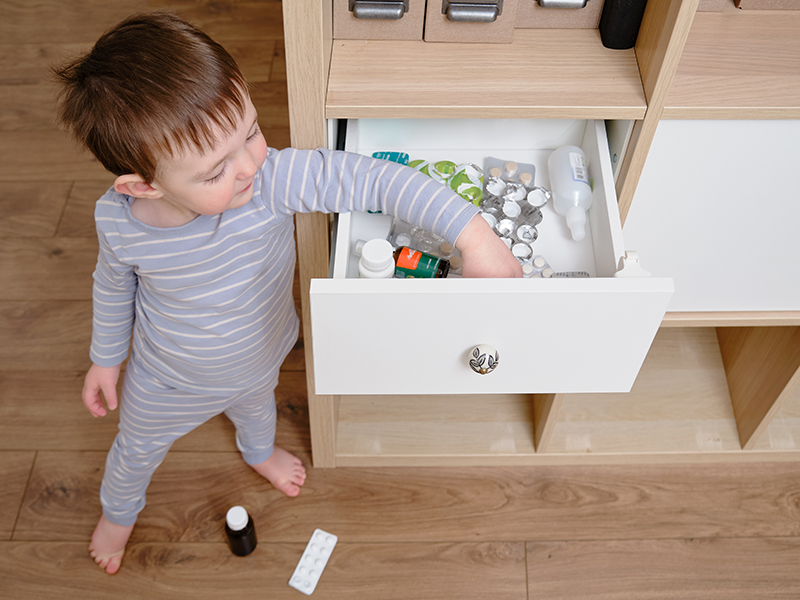Most poisonings occur at home. Here's where the danger lies and how to keep your family safer.
 When it comes to concerns related to your health and safety, as well as that of your family, you may not put poisoning at the top of the list. But you may be surprised to find out that there are more than two million cases of poisoning reported in the U.S. each year, and likely many more that are not reported. So even though this health hazard may not be top of mind, it's important to know what the top causes of poisoning are so you can take steps to stop them from being a danger to your family.
When it comes to concerns related to your health and safety, as well as that of your family, you may not put poisoning at the top of the list. But you may be surprised to find out that there are more than two million cases of poisoning reported in the U.S. each year, and likely many more that are not reported. So even though this health hazard may not be top of mind, it's important to know what the top causes of poisoning are so you can take steps to stop them from being a danger to your family.
Accidental poisoning is especially a risk for young children. But this age group is not the only one at risk. Older adults also are at an increased risk of unintentional poisoning. And people of any age may accidentally ingest, inhale or touch something that is dangerous without realizing what they are doing.
Here are some common causes of accidental poisoning:
- Medicine – These may be prescription or over-the-counter drugs. Not only are opioids of concern, but medicines for high blood pressure, diabetes, mental health, colds and coughs can be especially dangerous for children. Even if prescribed to your child, medicine can be harmful if ingested in large doses. Liquid medicines are often sweet and a child may consume a large dose if they get their hands on it.
- Cleaning products – Almost all types of cleaning products are made with chemicals that can burn skin and eyes, cause respiratory distress or result in even more serious health issues if ingested. Kids see adults using these products regularly and they may be left out on counters or tables, where children have easy access. These products should be treated as dangerous and locked up when not in use if you have young children in the house.
- Pesticides – Whether you have products on hand to kill weeds in your garden or ants in your kitchen, they can be especially toxic to humans. Pesticides should always be kept in a locked cabinet, out of reach of children. They should also be left in their original containers so they are not mistaken for something less toxic.
- Personal hygiene products – Those products sitting on your bathroom counter or in your purse, in pretty bottles and with attractive labels, may be toxic in the wrong hands. Children may find items like makeup, perfume and lotions fascinating, but don't understand the danger of putting the items in their mouths, spraying them in their eyes or swallowing them.
- Alcohol – Not only are alcoholic drinks dangerous to children because their bodies are not yet capable of metabolizing the alcohol, but alcohol may also be found in other products. This includes things like perfumes, mouthwash and hand sanitizers. While these items may seem harmless, they can cause risk of accidental poisoning in the wrong hands.
- Recreational drugs – As with medications, recreational drugs can be an extreme health hazard if consumed by young children. To make matters worse, more and more recreational drugs are being sold in forms that look appealing to children – such as gummy candies, cookies and lollipops.
If you suspect that someone has ingested, inhaled or otherwise come into contact with a toxic subject, call your local poison control center or the National Poison Control Hotline at 1-800-222-1222 for further instructions. You may need to take the person to the closest emergency room. Call 911 if the symptoms appear to be life-threatening.
Copyright 2024 © Baldwin Publishing, Inc. Health eCooks® is a registered trademark of Baldwin Publishing, Inc. Cook eKitchen™ is a designated trademark of Baldwin Publishing, Inc. Any duplication or distribution of the information contained herein without the express approval of Baldwin Publishing, Inc. is strictly prohibited.
Date Last Reviewed: January 17, 2024
Editorial Review: Andrea Cohen, Editorial Director, Baldwin Publishing, Inc. Contact Editor
Medical Review: Perry Pitkow, MD
Learn more about Baldwin Publishing Inc. editorial policy, privacy policy, ADA compliance and sponsorship policy.
No information provided by Baldwin Publishing, Inc. in any article is a substitute for medical advice or treatment for any medical condition. Baldwin Publishing, Inc. strongly suggests that you use this information in consultation with your doctor or other health professional. Use or viewing of any Baldwin Publishing, Inc. article signifies your understanding and agreement to the disclaimer and acceptance of these terms of use.
